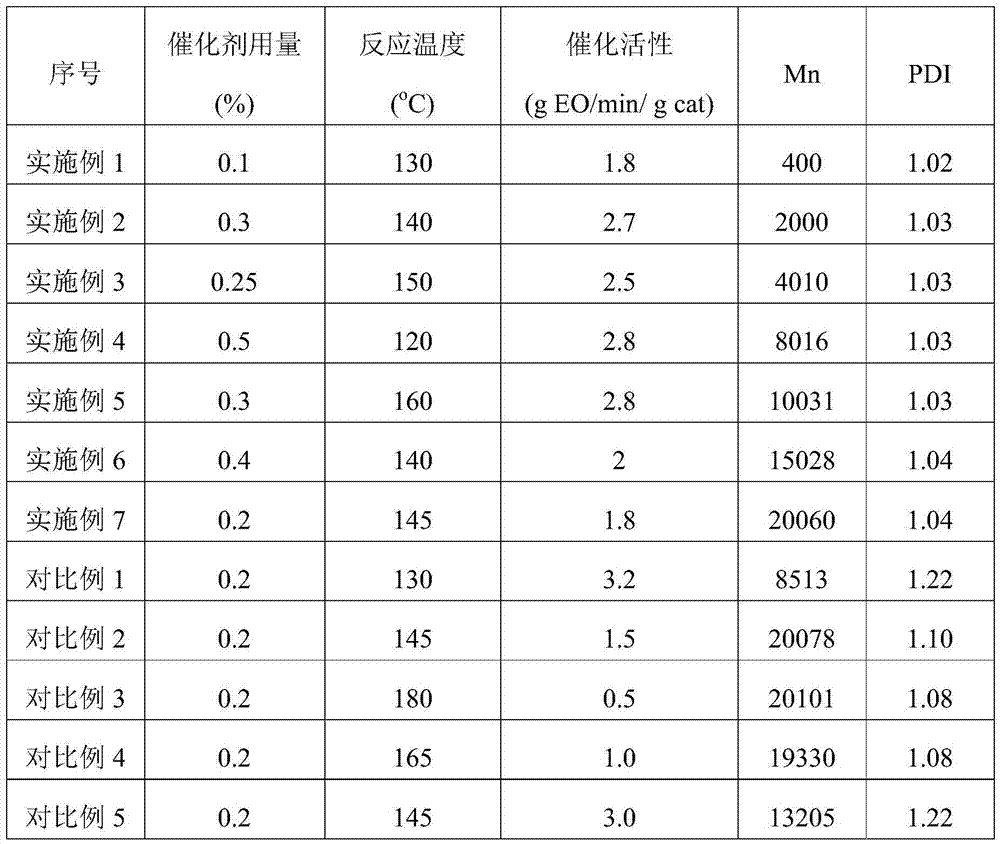Composite calcium-based catalyst and application thereof
A composite calcium-based catalyst technology, applied in the field of composite calcium-based catalysts, can solve the problems of polyethylene glycol molecular weight distribution, low catalyst activity, difficult product separation, etc. simple effect
- Summary
- Abstract
- Description
- Claims
- Application Information
AI Technical Summary
Problems solved by technology
Method used
Image
Examples
Embodiment 1
[0031]Drop into 400g diethylene glycol, 1.6g composite calcium-based catalyst (wherein potassium hydroxide accounts for 20% of catalyst weight, calcium hydroxide accounts for 70%, sulfuric acid accounts for 10%) in the dry 2L pressure reactor, seal reactor; Replace the air in the reaction kettle with nitrogen for 3 times, start stirring; raise the temperature to 100°C, dehydrate under the pressure of -0.09MPa for 60min; Add the alkanes at a rate to keep the reaction pressure at 0.3MPa, and the reaction temperature at 130°C for 417min; after the reaction, mature at 130°C for 30min, degas at -0.09MPa for 15min, and then cool to 90 After ℃, the pH was adjusted to 7.0 with acetic acid to obtain polyethylene glycol. The number average molecular weight and molecular weight distribution of the product were characterized by GPC gel chromatography, and the results are listed in Table 1.
Embodiment 2
[0033] In the dry 2L pressure reactor, drop into the product described in 250g embodiment 1, 3.75g composite calcium base catalyst (wherein sodium hydroxide accounts for 30% of catalyst weight, 2-ethylhexanoate calcium accounts for 60%, oxalic acid accounts for 10%), seal the reactor; replace the air in the reactor with nitrogen for 3 times, start stirring; heat up to 100°C, dehydrate under the pressure of -0.09MPa for 60min; heat up to 100°C, slowly add 1000g of ethylene oxide for polymerization Reaction; wherein, by controlling the addition rate of ethylene oxide so that the reaction pressure is maintained at 0.25MPa, the reaction temperature is maintained at 140°C for 99min; After degassing for 20 minutes, and then cooling to 90°C, the pH was adjusted to 7.0 with lactic acid to obtain polyethylene glycol. The number average molecular weight and molecular weight distribution of the product were characterized by GPC gel chromatography, and the results are listed in Table 1.
Embodiment 3
[0035] In dry 2L pressure reactor, drop into the product described in 150g embodiment 1, 3.75g composite calcium-based catalyst (wherein potassium hydroxide accounts for 30% of catalyst weight, and calcium phosphate accounts for 55%, and citric acid accounts for 15%), Seal the reaction kettle; replace the air in the reaction kettle with nitrogen for 3 times, start stirring; raise the temperature to 100°C, dehydrate under the pressure of -0.09MPa for 60min; raise the temperature to 120°C, slowly add 1350g of ethylene oxide to carry out the polymerization reaction; among them, By controlling the addition rate of ethylene oxide to keep the reaction pressure at 0.3MPa and the reaction temperature at 150°C for 144min; after the reaction, mature at 150°C for 30min, then degas at -0.09MPa for 20min , and then cooled to 90° C., and adjusted to pH 7.0 with lactic acid to obtain polyethylene glycol. The number average molecular weight and molecular weight distribution of the product were...
PUM
 Login to View More
Login to View More Abstract
Description
Claims
Application Information
 Login to View More
Login to View More - R&D
- Intellectual Property
- Life Sciences
- Materials
- Tech Scout
- Unparalleled Data Quality
- Higher Quality Content
- 60% Fewer Hallucinations
Browse by: Latest US Patents, China's latest patents, Technical Efficacy Thesaurus, Application Domain, Technology Topic, Popular Technical Reports.
© 2025 PatSnap. All rights reserved.Legal|Privacy policy|Modern Slavery Act Transparency Statement|Sitemap|About US| Contact US: help@patsnap.com



